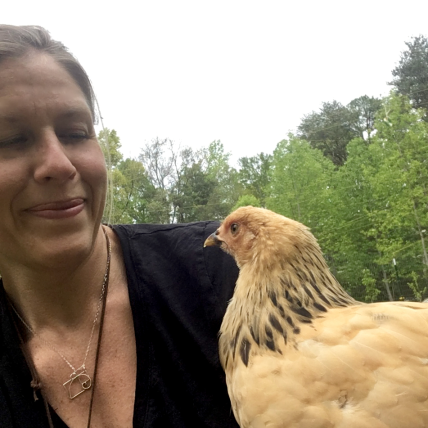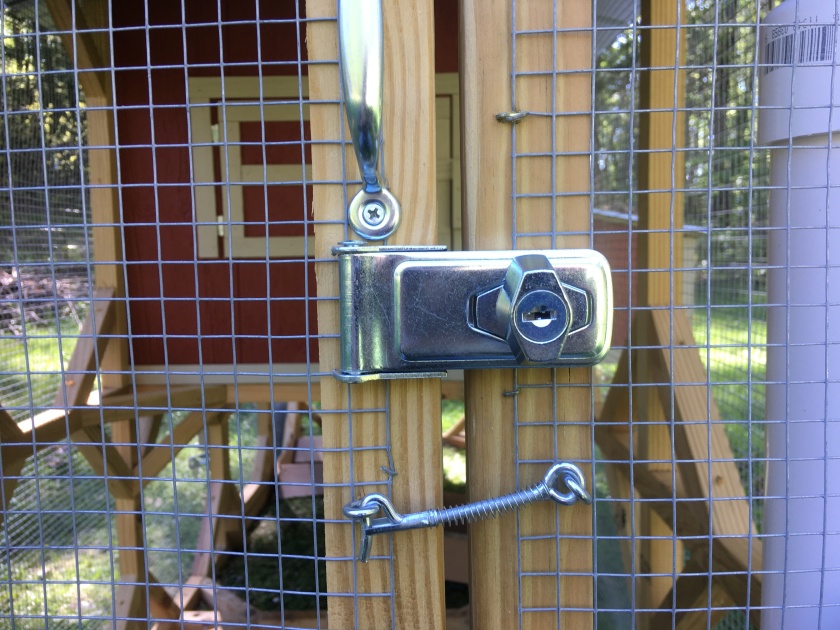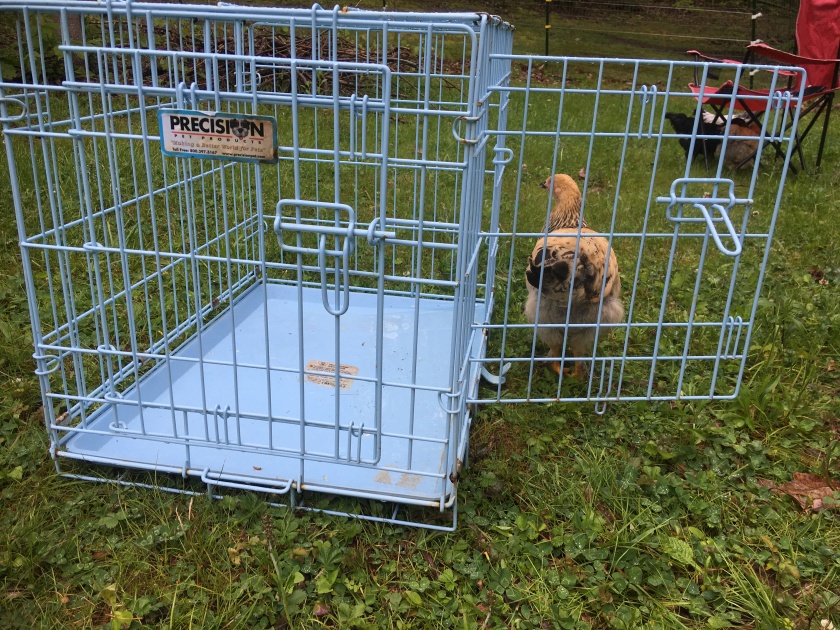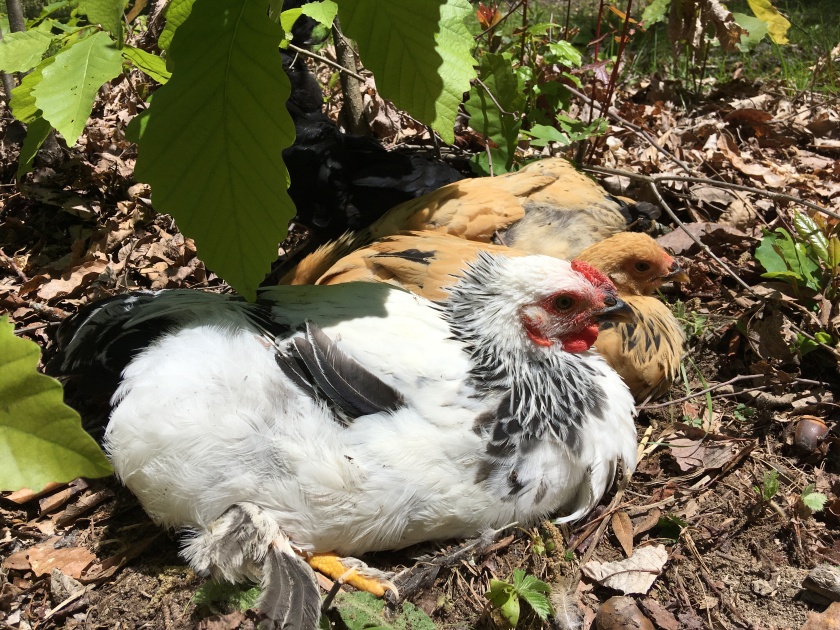by Beth
The chicks are living in the chicken tractor! Repeat: the chicks are living outside in the chicken tractor…almost full time.
Millie, the farm co-op chicken lady, told us we could expect to put chicks out some time in May, which sounded a little excessive back in February, but she was right.
They could’ve been out earlier if we had a closed coop with electricity, or if April had been as warm as it was the past 2 years. As it is, after learning to roost in week 8, the chicks were outside most of this week except during monsoons.
The birds look big and grown up, but they’re not. Every week is still full of changes, new challenges, and decisions. This week, the focus was on health, diet, and increased predator safety.
Day 57
Today was uncommonly gorgeous for this spring. In the morning, I pivoted the tractor to fresh grass, carried the chicks outside, and called our shed guy to put down the deposit on our new 6×8′ coop with a 6×16′ covered run. Normally I’d go straight back to deep clean the brooder space in the study, but we’re so giddy about the coop that I wanted to square away the details as early as possible.

I felt light the moment the deposit was down. The chicken coop, working name Chez Cluckmor, won’t be just another outbuilding. Purchasing a fixed coop is a deeper commitment to our homesteading dream. It’s surreal to look out and see chickens in the run, bee boxes and fruit trees in the orchard, seedlings in the garden, and Chris in the inflatable hot tub. Yes, there’s much more work to do. For instance, we have another house to build. But it’s been spectacular to reach the point where we feel like a homestead, and we’re celebrating it.
It’s also been hard work that demands continual problem-solving, obviously not just about chickens. But since this post is about chickens, here’s a chicken-based example: while deep cleaning the brooder, I was confronted with something serious: blood in a chick poop.
The amount was so small it was likely nothing. One of them probably ate too much hemp bedding out of the coop yesterday. However, blood anywhere outside an animal is a bad sign, and in poop it’s a symptom of coccidiosis, a disease that kills chicks. It lives in the soil and is so common and deadly that many people treat before chicks touch the ground. It’s why I’ve been giving them dirt and oregano and slowly acclimated them to the outdoors: to build immunity. Gradual exposure is said to prevent or slow coccidiosis.
It’s also why I bought a bottle of medication called Corid weeks ago and stowed it in the chicken kit. I dislike medicating for unconfirmed illness, but now wasn’t the time to be conservative. Coccidiosis can take out an entire flock, fast. I stirred a teaspoon of Corid into a quart jar of fresh water. At the tractor, I swapped the chicks’ water for Corid water and looked over each bird. Nobody was puffed up or sulking to the side. Their feathers were shiny, and they were all eating and drinking. Drinking Corid water for a week should interrupt the cycle of the disease and let them beat any infection that may have occurred.
I scoured the brooder bin and was appalled a 2nd time when I went to sterilize the waterer. There were bits of black mold floating in the water, suspended like jellyfish. What on earth? The chicks are usually outside, so I don’t refresh this water as much. It was probably 3 days old. I always put down a couple saucers because the chicks prefer saucers to the chicken-nipple waterer (don’t judge me; they’re so darn cute), but I know some of them drank the mold water this morning. Mold can cause a host of other deadly illnesses, like botulism. Sigh.
I finished cleaning and checked on the chicks again. They looked normal, and so was the rest of the day. I watched them like the hawks. Nobody developed weird symptoms.

In the evening, I switched on the camping light in the coop. The radar forecast rain throughout the night, but with no wind, a low of 56, and everybody as happy as ever, this seemed like a good night to maybe leave them out for the first time.
Rain started at dark. Would the sound on the tractor’s metal roof scare them? I suited up to check and found fat chickens asleep on the roost bar. I quietly slid a waterer and tray of feed into the coop so they wouldn’t have to go down the ramp. Blindingly bright motion-sensor lights dotted the perimeter of the tractor so no predators could approach without causing a stir.
I walked down to check on them a couple more times. Cogburn and a few others hopped off the roost bar to visit me but weren’t peeping. They were finishing the tray of feed and hopping back on the roost bar as I latched the tractor doors one last time at 1 a.m., tested the motion-sensor lights again, checked the latches again, and walked up to bed.
In the barn, I cracked a window to be extra sure the dogs would wake up to any ruckus. When insomnia woke me throughout the night, I’d train the binoculars at the glow of the camping light on the coop ramp. There were no chicks down in the run, even during a 2nd rainstorm that blew through.
It was their first full night out, at 8 weeks old + a day.
What’s interesting is that a chicken can live 10-12 years, similar to a dog, and 8 weeks is often when we send puppies out into the wild, too.
Day 58
This morning, I went to the tractor bright and early with food and fresh Corid water. The chicks were already in the run and excited to about food. Less excited about me. Teenagers. The run was damp. It rained 0.2″ last night. In contrast, last week it rained up to 2″ a night with 20 mph wind.

After coffee, I went back down to let them out. When the chicks were safely foraging on the other side of the run, I pivoted the tractor to fresh ground. They’re each still acting sociable and healthy and were easy to herd back into the tractor each time I had them out today. I think they’re sleepy from the slumber party last night. They disappeared into the coop throughout the day.
In the evening, there was a funny chirping. I looked out to see a wild turkey wandering through. She probably has a nest nearby, which means she only has a couple hours a day to eat. Through the binoculars, I could see Cogburn watching her from the tractor, acting casual. No telling what they think of their wild-poultry neighbors.

The forecast for the night was “calm.” I actually don’t remember that word in our forecast this year. The temperature was supposed to dip to 48°F.
At 10 p.m., it was 55°, and the chicks were happy. I set the alarm for 1 a.m. to see how they were when the temperature was lower. Still good! They spent another night outside.
Day 59
Everybody looks healthy, just spending time outside doing chicken things, like napping in the sun. So feathery!

However, the brief bout of calm, warmish weather deteriorated throughout the day. In the evening, nasty wind kicked up. Then, hard rain. Then a tornado watch. None of which was forecast. The radar showed tiny patches of green, but we were in a monsoon.
The chicks weathered the storm in the tractor. The rain was so hard it turned the motion-sensor lights on and off. I watched the disco through the binoculars to make sure they stayed up in the coop. They did, though the hard rain was probably disconcerting. Later, the weather mellowed, and they were able to spend the night in the tractor again.
Day 60
I let them out first thing this morning to decompress from last night’s harsh weather. They foraged in the yard while I added keyed hasp latches to the tractor’s doors to foil raccoons. We see families of up to 5 raccoons – we call them “wash bears” – at a time. Those dexterous critters can apparently figure out multi-phase latches, but keys are safely beyond their skillset.

We’ve been trying to imagine and head off worst-case scenarios. For some reason it’s easier to envision the weak points of our predator proofing now that they’re outside full time.
Almost full time. Today, the weather grew worse and worse. By 3:30, it was 48° with 18mph gusts and sideways rain. They already had a hard night last night. It seemed like too much. I went to collect them and was validated: they were huddled in the corner of the coop, looking concerned, instead of roosting with their normal self-satisfied chicken smirks. In the study, they quickly fell into house-chicken mode, congregating on the rim of their brooder bin, and Cogburn fell asleep on my lap.
A lot of people might’ve left them out. A lot of people wouldn’t have. For us, until they’re a little older – and clucking instead of peeping, because they still sound like baby birds – there’s no reason to make them endure so much inclement weather.
Day 61
It was even colder than forecast last night, down to 40°, which makes me extra glad the chicks were in. They were outside again by mid morning in the high 40s.

Today we decided to venture out for chicken supplies. Their pine bedding, chick grit, and feed are all almost gone. We have almost an entire bale of the pricey hemp bedding that arrived in week 8, but now that we have a fixed coop coming, I’ll save it. At least 1/4 of the hemp in the tractor’s coop has fallen out of the floor hole already.
On the positive side, they don’t eat quite as much of the hemp as they do pine chips. Eating bedding is a bad habit. It’s the worst kind of junk food. It can lodge in their crops and cause an impaction that has to be treated with olive oil – or just make them feel full without providing any calories or nutrients.
Not that these birds seem malnourished. They’re huge, and we’ve gone through approximately 70lb of feed in 9 weeks. This doesn’t mean each chick has eaten 10lb of feed. A large percentage ends up on the ground or as dust in the bottom of the feeder they ignore. My goal was to find less dusty feed with fewer by-products and preservatives than the chick starter won at the farm co-op chicken-seminar raffle.
Unfortunately, options are limited in our town. We can drive to adjacent counties for more variety, but it would be ideal to find a reliable feed we can pick up around here. I like fermenting the Scratch’n’Peck and will order a bag of their grower feed for 8-20-week-old chicks, but because there’s no local source for that feed, the shipping makes it too pricey to use as a “sole ration.” Plus, there’s controversy about the separation of nutrients in whole-grain feeds. People say chickens pick out the tasty parts, leaving behind pieces that might have essential nutrients, leading to malnutrition and illness.

Our chickens find plenty of whole, live foods in the run, so I’ll probably transition away from the expensive feed as the flock grows, but for now I like the option to ferment it, and it has fish protein, which the birds aren’t getting elsewhere. It seems like a good thing to give them. I really have no idea.
Before we went out, I made a shortlist of locally available feeds to try, researching ingredients online to avoid spending time in the store reading labels. Feeding organic would be good, but all but one brand, Purina, in our stores have diatomaceous earth. DE might kill flies in the feed bag, but there shouldn’t be flies in there anyway, and science has easily debunked the claim that DE kills worms in chickens’ digestive tracts.
The presence of DE made it feel like those brands were peddling a gimmick and therefore a waste of money. Many things labeled “organic” have their own shortcomings, so besides the Purina organic, I added to the list a couple types of non-organic feed with fewer byproducts and preservatives.
As expected, chicken-supply choices at the farm co-op were slim. We bought a bag of chick grit and went across the parking lot to Tractor Supply for a $6 bale of pine flakes and a 35lb bag of Purina organic chick starter/grower.
The Purina feed smells like rancid oil and will be returned tomorrow. I looked for an expiration date and found the ingredient tag ripped off, a red flag they’re selling feed past its sell-by. Chicken feed is in such high demand it’s not surprising they’d be digging into the bottom of their stock, but if our choices are a) rancid and organic, b) diatomaceous earth and organic, or c) fresh but not organic, we’ll choose C.
My only other chicken concern for the day was how cold it would be overnight: mid 40s. No wind, at least, but it’s chilly with no warm sun for respite. Already, they seem a little irritated by the bad weather, but it could be because they’re teenagers. They’ve been more testy. All the chicks have now squared off with one another at some point. Even BeBe is standing up to the others. There’s some chest bumping, and I saw Cogburn peck Miss Eula’s head once, hard, which is unusual.
At dark, they crashed on the roosts in the coop. They were so settled in I decided to leave them outside but set alarms to check on them at 2 and 4 a.m. Each time I sleepwalked past the tractor, they peeped quietly, stood up, stretched their legs, and sunk back down to sleep. They were acting the way they act when they sleep in the study, so I left them out all night again.
Day 62
I checked on the chicks first thing and filled their food, then went inside for coffee and came out 30 minutes later to let them into the yard. Kneeling down to greet them, I noticed each chick had a small scrape across its beak. Peep and Eula, the mean twins, had it the worst.
Suspiciously, one chick’s beak was un-scratched. Cogburn. Did our glorious baby floof of a rooster do this?
And what did I need to do? Supposedly blood is a siren call for chickens to attack each other and make it worse, but the scratches were impossible to clean up. They say to separate an injured chicken, but we don’t have accommodations to separate 7 chicks.
I let them exercise a long time, hoping the blood would dry and fade. Nobody was pecking or acting unusual, and the time out foraging in the dust seemed to work as a cover-up. If you don’t know Eula’s beak, you can hardly see the scratch here.

After they were back in the tractor, I hit the internet. Unsurprisingly, the first advice for a rooster who pecks hens is the stew pot. Really? Setting aside any emotional connections, we’ve spent 2 full months raising these birds. We’re not going to default to “harvesting” any of them without trying to train first, especially when training has been easy.
It took digging to find the non-murderous advice, like making sure they have enough space, food, grit, and water, which they do, as well as sunny spots to dustbathe regularly. Check!

One article advised to give them something else to peck, like a flock block, a patty of seeds and treats. We bought one of sunflower seeds and mealworms this afternoon, when we returned the rancid feed.

Here’s another thing: it might not have been Cogburn. While it is possible he wanted to assert himself to the flock – especially to the 2 most aggressive hens, Peep and Eula, who were the most injured – it’s also possible the stress of cold weather amped everybody up, and there was a brief peck fight between the pullets.
Another theory: something yummy like a cricket was outside the run, and the chicks scraped their beaks on the wire mesh trying to catch it. Peep and Eula would go after it most vigorously. Cogburn waits to take treats until the hens have them, so the num-num could have hopped off before he had a chance to peck and scrape his beak.
We may never know what happened but won’t condemn Cogburn any time soon. Tis a goodly pleasant bird. Here he is dustbathing with the ladies this afternoon, conflict free.

The theory that the birds didn’t do this to each other seemed to be backed up by the fact that no beaks were pecked again despite obvious spots of blood. These chicks have their pecking-order disputes, but nothing so violent. Given their spacious conditions and abundance of food, grit, water, sunshine, exercise, and dust to bathe in, it would be bizarre if they started drawing blood like this as a group. I mean, one bird might be on the receiving end of a good peck at times, but all of them?
In other news, I spread new pine chips in the tractor and most of them were scratched out of the hole in the floor in about an hour.

Chips are cheap, and it’s not bad to have them in the run to absorb moisture. What’s interesting is how fast they scratched the pine chips out while they left the hemp. Maybe it was a brooder throwback. Scratching pine chips was a favorite activity in the bin.
The new, non-organic food looks boring but smells fresh, and kind of like dog food.

In comparison, the lowest-end starter feed from the chicken-seminar raffle, which also smells fresh, smells like Grape Nuts. The highest-end, whole grain, non-GMO, no corn, no soy, organic Scratch’n’Peck smells like fish oil. Stinky.
The chickens like it all.
Day 63
They’re 9 weeks old today! Their beaks are healing. Today started warm but windy. Rain was forecast later, so I made sure to sneak in time to supervise them in the run before work and over lunch.
We keep a chair in the run to sit with them. In the evening, 20mph gusts came through and blew that chair over, along with extremely heavy rain falling in sideways sheets.
Ugly as it was, it wasn’t an unusual storm for this spring, but for some reason, the chicks wouldn’t go into the coop. They were down in the run getting soaked. I ran down with a container of mealworms to coax them up the ramp into the coop. Cogburn was already in there, but most of the hens would walk up for a minute, then go back down to be rained on. They were very unhappy. Happy to peck mealworms out of the container, then very unhappy again.
The rain broke for a second. I popped the door to the tractor and coaxed 5 chicks into the crate and ran them up to the barn. I ran back down for Cogburn and Donna, who were now at the door of the tractor, beside themselves waiting to be brought in.
Out of the rain, it took no time for them to relax and start scratching and hopping on and off the brooder and box village. It seems to be easy to change a chicken’s mood. I tried to dry the wettest birds with a cloth, but it wasn’t necessary. Healthy chicken feathers are mostly water resistant. They shook off a few times and looked normal again.
They’ll be out in the morning and may spend a few more frigid April nights in the house. As Miss Millie predicted, they’ll be out full time in May, which begins in week 10.

Beth, are you getting any sleep?
LikeLike
Ha ha 🙂 As much as ever 😉
LikeLike
Wow. I never knew raising chickens required so much. It sounds like raising a house full of kids and appears you are enjoying every minute!
LikeLiked by 1 person
We were warned how much work it is to raise chicks vs. buying birds already laying eggs. Of course I ended up taking it up a level with all the time at home. There has been a lot to learn, so I’m grateful for the time to focus. Big silver lining. And yes, it’s been enjoyable!
LikeLike
You need a cheap harbor freight camera so you don’t have to go outside to check on them all the time!
LikeLiked by 1 person
I was thinking baby monitor 😉
LikeLike